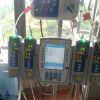Understanding the Stages of Heart Failure: A Detailed Guide
Heart failure is a serious condition that affects millions of people worldwide, yet it is often misunderstood. While many people are familiar with the term "heart failure," fewer are aware of the stages through which the condition progresses. Understanding these stages is crucial for both patients and caregivers, as it helps in managing symptoms, making informed decisions, and seeking timely medical intervention. In this article, I will explain the different stages of heart failure, the symptoms to watch for, and the treatment options available to those facing this condition.

1. What is Heart Failure?
Heart failure, often referred to as congestive heart failure (CHF), is a condition in which the heart is unable to pump blood effectively throughout the body. This means the heart can't meet the body’s need for oxygen and nutrients, which can lead to fluid buildup, shortness of breath, fatigue, and other complications. Despite the term "failure," it doesn't mean the heart has stopped working entirely; instead, it is a sign that the heart is not functioning at its full capacity.
Heart failure can develop gradually and can worsen over time. There are different causes of heart failure, including coronary artery disease, high blood pressure, diabetes, and prior heart attacks. Identifying the stages of heart failure is essential to managing the condition and slowing its progression.
Atlanta Heart Specialists
atlanta heart specialists
4375 Johns Creek Pkwy #350, Suwanee, GA 30024, USA

2. The Stages of Heart Failure: From Early to Advanced
Heart failure is categorized into different stages based on the severity of the condition. These stages help doctors and healthcare providers tailor treatment plans to each patient. The most common system for classifying heart failure is the American College of Cardiology (ACC)/American Heart Association (AHA) stages of heart failure, which includes four stages, from Stage A (at risk for heart failure) to Stage D (advanced heart failure). Let’s explore each of these stages in more detail.
Stage A: At Risk for Heart Failure
Stage A of heart failure is characterized by a high risk of developing heart failure but no current symptoms. People at this stage may have underlying conditions such as high blood pressure, diabetes, or a family history of heart disease. While heart failure symptoms are not yet present, it is essential for individuals at this stage to manage risk factors to prevent progression to later stages of heart failure.
Prevention at this stage is critical. Lifestyle changes such as a healthy diet, regular exercise, and managing chronic conditions can help reduce the risk of heart failure. Regular check-ups with a healthcare provider are necessary to monitor heart health.
Stage B: Structural Heart Disease
In Stage B, individuals have structural heart changes that indicate damage or an increased risk of developing heart failure. This stage may include conditions like a previous heart attack, thickened heart walls, or an abnormal heart valve. Although people in Stage B may have no symptoms, the risk of developing heart failure is higher.
At this stage, doctors will likely recommend medications and lifestyle changes to help prevent further damage to the heart. Medications such as ACE inhibitors, beta-blockers, and other heart-related medications can help reduce strain on the heart and slow the progression to Stage C.
Stage C: Symptomatic Heart Failure
Stage C is where symptoms of heart failure begin to appear. People with Stage C heart failure may experience shortness of breath, fatigue, swelling in the legs and ankles, and difficulty performing physical activities. The heart is no longer able to pump blood effectively, and fluid builds up in the lungs and other parts of the body.
At this stage, patients may require stronger medications to help manage symptoms. Common treatments include diuretics to remove excess fluid, ACE inhibitors to help relax blood vessels, and aldosterone antagonists to reduce fluid retention. In some cases, doctors may recommend surgery or devices like pacemakers or defibrillators to help the heart function more effectively. Regular monitoring by healthcare professionals becomes even more critical at this stage.
Stage D: Advanced Heart Failure
Stage D represents advanced heart failure, where the heart can no longer pump enough blood to meet the body's needs, even with medication. At this stage, patients may experience severe shortness of breath, inability to exercise, and other life-threatening symptoms. People with Stage D heart failure may also experience organ failure as a result of poor blood flow.
For individuals in Stage D, aggressive treatments may be necessary, including heart transplantation or the implantation of a left ventricular assist device (LVAD). Hospice care and palliative care may also be options to improve the quality of life and provide comfort. The focus at this stage shifts to managing symptoms and providing supportive care.
3. Symptoms to Watch for at Each Stage
The symptoms of heart failure can vary significantly between stages, and it’s important for individuals to recognize the early signs and seek medical attention. At Stage A, there may be no noticeable symptoms, but as heart failure progresses through Stages B and C, individuals may begin to notice fatigue, difficulty breathing, and swelling. By Stage D, symptoms can become much more severe, and patients may require immediate medical intervention.
Early detection of these symptoms is crucial to preventing further damage to the heart and improving outcomes for individuals with heart failure. If you or a loved one experience any of the symptoms associated with heart failure, it is important to consult with a healthcare provider promptly.
4. Treatment Options for Heart Failure
Heart failure is a chronic condition that requires ongoing management. Treatments for heart failure depend on the stage and severity of the condition, but they generally focus on improving heart function, managing symptoms, and preventing complications. The treatment options can include lifestyle changes, medications, devices, and in severe cases, surgery or heart transplants. A healthcare provider will develop a personalized treatment plan based on the patient’s stage of heart failure and overall health.
5. Lifestyle Changes to Help Manage Heart Failure
In addition to medical treatments, lifestyle changes play an important role in managing heart failure. A heart-healthy diet, regular exercise, stress management, and quitting smoking are all important factors in improving heart function and overall health. People with heart failure should also work closely with their healthcare provider to monitor their condition and adjust their treatment plan as needed.
Ultimately, the goal is to slow the progression of heart failure, reduce symptoms, and improve quality of life. By making proactive changes and following a comprehensive treatment plan, individuals with heart failure can live fuller, healthier lives.





















Deborah Heart and Lung Center
deborah heart and lung center
200 Trenton Rd, Browns Mills, NJ 08015, USA